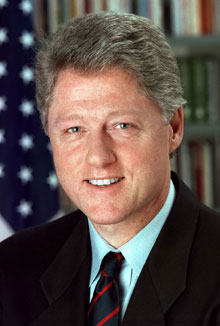On January 7, 1999, the impeachment trial of President William Jefferson Clinton began in the US Senate. William (Bill) Clinton was only the second US President to face such a congressional procedure. Earlier in 1868, the trial of President Andrew Johnson had been the first instance of a Senate trial in the history of the US. Following the edicts of Article 1 of the US Constitution, Justice William Rehnquist, the then Chief Justice of the US Supreme Court presided over the proceedings while thirteen House Republicans from the Judiciary Committee acted as prosecutors or managers of the trial. The 100 senators of the US Senate were sworn in as jurors. In 1994, Ms. Paula Jones, a young woman from Arkansas filed charges against President Bill Clinton alleging sexual harassment in 1991. Amidst the controversy surrounding the case and the investigation by independent counsel Kenneth W. Starr, of the Whitewater corruption allegations, President Clinton engaged in an illicit sexual affair with a White House intern, Ms. Monica Lewinsky. In the course of her 18- month stint at the White House, Ms. Lewinsky and the President engaged in about 10 sexual encounters. Ms. Lewinsky was transferred to the Pentagon in 1996 where she befriended Linda Tripp. In her conversations with Ms. Tripp, Ms. Lewinsky detailed her relationship with the President. Ms. Tripp started to secretly tape-record Lewinsky’s telephone conversations which were often emotional. Ms. Lewinsky was subpoenaed in the Paula Jones case in order to establish a pattern of sexual misconduct by President Bill Clinton and she denied the affair in an affidavit. Starr soon came to know that the White House had been involved in assisting Ms. Lewinsky find employment and also in finding a lawyer to file the affidavit. With the permission of the US State Justice Department, Starr expanded his investigation, determined to prove that the President had committed perjury and obstruction of justice by encouraging Ms. Lewinsky to lie. Ms. Lewinsky was subsequently intercepted by the FBI and confessed to the affair. Following this, President Clinton swore in his deposition that he did not have any sexual relations with Ms. Lewinsky – the basis of his impeachment. For the many months following this, the President and his friends denied his relationship in public. In July 1998, Starr egged Ms. Lewinsky into providing him DNA evidence of her sexual relationship with the president. With the evidence secure, Starr also persuaded Ms. Lewinsky to testify in front of a federal grand jury. The President also appeared before the jury but did not answer specific questions. Later, that night he confessed to the relationship on national TV. On September 9, Starr delivered a 453-page report to the US House of Representatives. The report cited 11 impeachable offenses allegedly committed by the President. He added to this 36 boxes of evidence. On September 11, the Republican-controlled House Judiciary Committee started to release the Starr report to the public through media and Internet leaks. On October 8, House Resolution 581 was approved by the House and a 258 to 163 vote was cast in favor of authorizing and directing the Judiciary Committee to investigate if sufficient grounds existed for the impeachment of the President. On December 11, the House Judiciary Committee approved four articles of impeachment and released a full report on December 16. After the ensuing debate, the House of Representatives approved two of the four articles alleging that the President committed perjury in the Paula Jones case and had obstructed justice. On December 19, the House impeached President Clinton. The impeachment trial in the Senate commenced on January 7, 1999. The impeachment trial lasted five weeks and ended on February 12, 1999. The US Senate chose closed-door deliberations on the verdict and emerged to acquit President Bill Clinton on both the articles of impeachment – obstruction of justice and perjury. The trial managers presenting the case needed a two-third majority (67 votes) to convict the president and to remove him from office. They, however, failed to achieve a simple majority. On the charge of perjury, about 45 Democrats and 10 Republicans returned a “not guilty” vote. This includes Senator Arlen Specter of Pennsylvania’s vote which read “not proven,” and was subsequently considered a “not guilty” vote by Chief Justice Rehnquist. On the charge of obstruction of justice, the Senate returned a 50-50 vote. Following the trial, Bill Clinton went on to say that he was “profoundly sorry” for the burden that his behavior had imposed on the people of the US and the American Congress. President Bill Clinton went on to complete the term of his presidency but the scandal severely damaged his reputation and that of White House. It was also responsible for Republican Senator Gorge W. Bush’s resounding success in the 2000 US presidential campaign and the defeat of Vice President Al Gore. You may also like : January 7 1943 – Inventor Nikola Tesla Dies in New York
January 7 1999 – US President Bill Clinton’s Trial For Impeachment Began In The Senate
On January 7, 1999, the impeachment trial of President William Jefferson Clinton began in the US Senate. William (Bill) Clinton was only the second US President to face such a…
409
previous post
